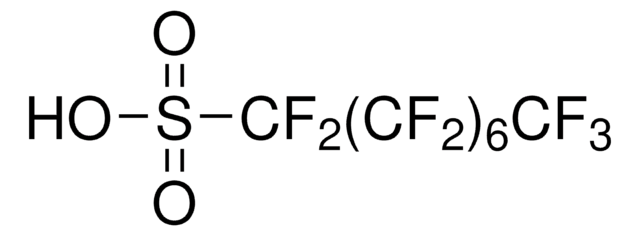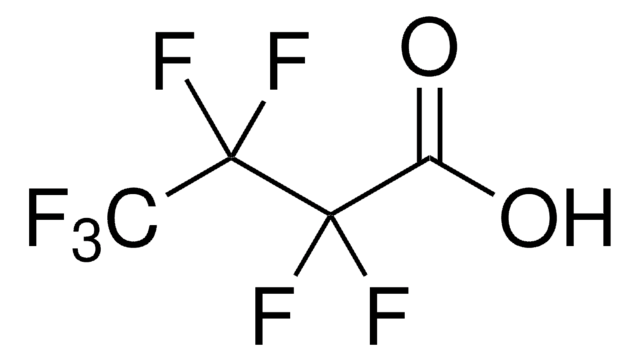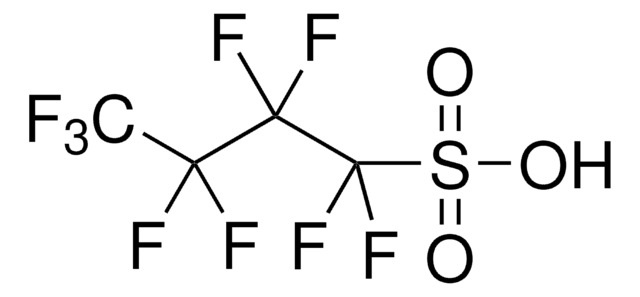77282
Heptadecafluorooctanesulfonic acid potassium salt
≥98.0% (T)
Sinónimos:
Perfluorooctanesulfonic acid potassium salt, Potassium heptadecafluoro-1-octanesulfonate
About This Item
Productos recomendados
Nivel de calidad
Ensayo
≥98.0% (T)
Formulario
crystals
mp
277-280 °C (lit.)
grupo funcional
fluoro
sulfonic acid
cadena SMILES
[K+].[O-]S(=O)(=O)C(F)(F)C(F)(F)C(F)(F)C(F)(F)C(F)(F)C(F)(F)C(F)(F)C(F)(F)F
InChI
1S/C8HF17O3S.K/c9-1(10,3(13,14)5(17,18)7(21,22)23)2(11,12)4(15,16)6(19,20)8(24,25)29(26,27)28;/h(H,26,27,28);/q;+1/p-1
Clave InChI
WFRUBUQWJYMMRQ-UHFFFAOYSA-M
¿Está buscando productos similares? Visita Guía de comparación de productos
Descripción general
Aplicación
- A fluorinated surfactant for poly(vinylpyrrolidone)/aminopropyl-functionalized nanoclay films to achieve hydrophobicity and oleophobicity.
- A surfactant in the preparation of core-shell polymers for lithium-ion batteries.
- A reactant to synthesize dicationic ionic liquids.
Palabra de señalización
Danger
Frases de peligro
Consejos de prudencia
Clasificaciones de peligro
Acute Tox. 3 Oral - Acute Tox. 4 Inhalation - Aquatic Chronic 2 - Carc. 2 - Lact. - Repr. 1B - STOT RE 1
Código de clase de almacenamiento
6.1C - Combustible acute toxic Cat.3 / toxic compounds or compounds which causing chronic effects
Clase de riesgo para el agua (WGK)
WGK 3
Equipo de protección personal
dust mask type N95 (US), Eyeshields, Faceshields, Gloves
Listados normativos
Los listados normativos se proporcionan para los productos químicos principalmente. Para los productos no químicos sólo se puede proporcionar información limitada. Si no hay ninguna entrada, significa que ninguno de los componentes está en la lista. Es obligación del usuario garantizar el uso seguro y legal del producto.
EU REACH Annex XVII (Restriction List)
Elija entre una de las versiones más recientes:
¿Ya tiene este producto?
Encuentre la documentación para los productos que ha comprado recientemente en la Biblioteca de documentos.
Los clientes también vieron
Nuestro equipo de científicos tiene experiencia en todas las áreas de investigación: Ciencias de la vida, Ciencia de los materiales, Síntesis química, Cromatografía, Analítica y muchas otras.
Póngase en contacto con el Servicio técnico











